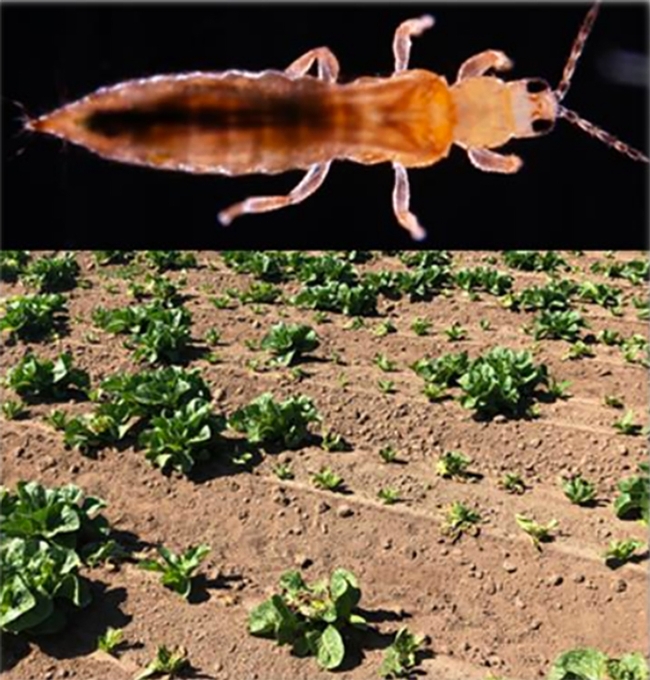
But thrips do pack a powerful punch.
A major pest of many agricultural crops, including lettuce, they damage plants by (1) sucking their juices and (2) transmitting viruses.
If you've been following the thrips damage in the lettuce production in the Salinas Valley, or want to know more about thrips, the UC Davis Department of Entomology and Nematology's virtual seminar on Wednesday, Jan. 20 should interest you.
Research entomologist Daniel Hasegawa of the Crop Improvement and Protection Research Unit, Agricultural Research Service, U. S. Department of Agriculture, will speak on "Landscape and Molecular Approaches for Managing Thrips and Thrips-Transmitted Viruses in the Salinas Valley" at the department's first seminar of the winter quarter.
The hour-long virtual seminar, via Zoom, begins at 4:10 p.m., announced agricultural Extension specialist Ian Grettenberger, seminar coordinator. To access the seminar, fill out this Google form link at https://bit.ly/3oWYjnt.
"In 2019-2020, lettuce production in the Salinas Valley of California was devastated by thrips-transmitted impatiens necrotic spot virus (INSV)," Hasegawa says in his abstract. "Due to the inherent challenges in managing thrips using conventional chemical tactics, and no direct means for managing the virus, there is a strong need for new management strategies."
This seminar, he says, will provide an overview of
- The challenges in managing thrips and INSV in lettuce production
- What we've learned about the epidemiology of thrips and INSV, and
- Opportunities to improve cultural practices and develop biotechnology tools, such as RNAi for managing thrips and INSV in the Salinas Valley.
Hasegawa joined the Salinas USDA-ARS team in May 2019 after serving as a postdoctoral research associate (molecular biology) for three years with the USDA-ARS in Charleston, S. C. He specializes in vector entomology, molecular biology and biotechnlogy. "My lab uses a variety of techniques to understand insect vector-virus relationships that impact plant health and agriculture," he says on Linked In. "We use molecular, genetic, and epidemiological concepts to understand drivers of vector-borne transmission of pathogens and utilize genetic technologies (e.g. RNAi and CRISPR), to improve agriculture productivity and sustainability."
Hasegawa received his bachelor of science degree in biochemistry in 2007 from UC Riverside and his doctorate in biology from Clemson University in 2013.
The mission of the Crop Improvement and Protection Research Unit is to improve germplasm of lettuce, spinach and melon, determine basic biology of viral, fungal and bacterial diseases affecting these crops, develop alternatives to methyl bromide as a soil fumigant for control of soilborne pests in strawberry and vegetables, reduce postharvest losses of lettuce, develop scientifically based organic crop production practices, and develop methods for control of weeds. (See more on the Pacific West Area website.)
"More than 90 percent of the lettuce sold in the United States is grown in California, and the majority of production from April through October occurs in the Salinas Valley, while production form November through March occurs in California's Imperial Valley," according to keepcaliforniafarming.org.
The UC Statewide Integrated Pest Management Program (UC IPM) says this about thrips: "Thrips, order Thysanoptera, are tiny, slender insects with fringed wings. They feed by puncturing the epidermal (outer) layer of host tissue and sucking out the cell contents, which results in stippling, discolored flecking, or silvering of the leaf surface. Thrips feeding is usually accompanied by black varnishlike flecks of frass (excrement). Pest species are plant feeders that discolor and scar leaf, flower, and fruit surfaces, and distort plant parts or vector plant pathogens. Many species of thrips feed on fungal spores and pollen and are often innocuous. However, pollen feeding on plants such as orchids and African violets can leave unsightly pollen deposits and may reduce flower longevity. Certain thrips are beneficial predators that feed on other insects and mites."
"Thrips can readily move long distances floating with the wind or transported on infested plants, and exotic species are periodically introduced," UC IPM notes.
Attached Images:
